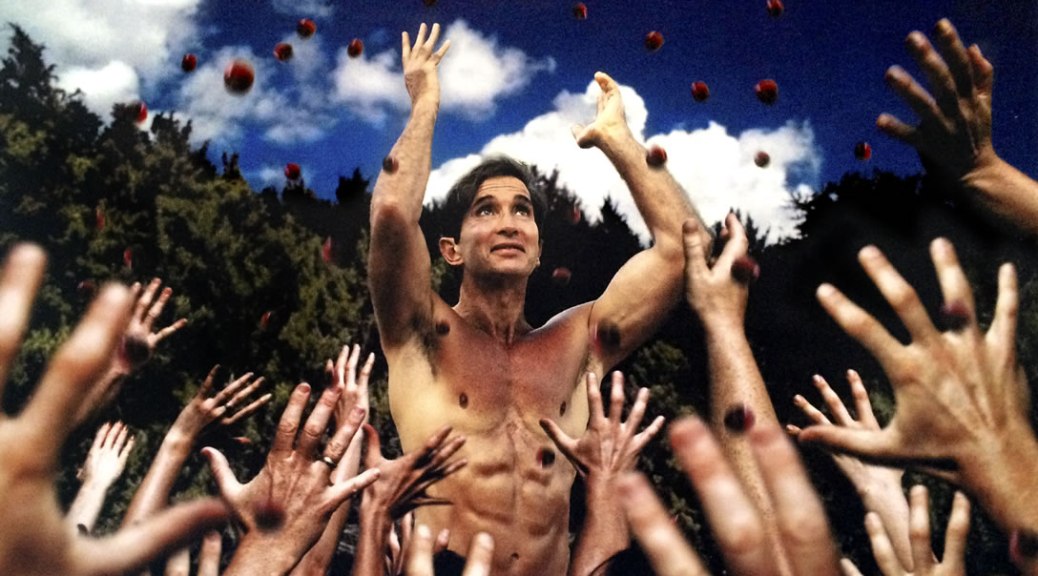A film studies student such as myself often views for analysis only those documentary films that are radical, experimental, or genre defining. This neglects the more commonplace documentary of speculation, event dissection, or character study.
Holy Hell, in film studies rhetoric, could be considered a “synthetic documentary” not in that it is fabricated, but in that it, from scene one, incorporates multiple media forms in order to convey its aesthetic. As director Will Allen provides voiceover on how he grew up with much introspection into the nature of his own existence, we see footage of his childhood films, photographs of Allen as a teenager, and an animated drawing of a man among stars.
The film progresses in similar fashion, mixing talking head interviews with still images and film footage of the cult that Allen lived within for 22 years. This said, it is far less ambitious in a formal sense than other synthetic docs.
Holy Hell may be viewed as riding the wave of last year’s Going Clear, which opened up the doors into the convoluted world of Scientology, but where Going Clear captures the quiet hysteria inside and the utter confusion outside of the religion it depicts, Holy Hell tries to capture the perspective of the people who turned to the Buddhafield cult for guidance. The first we see of the talking head interviews are our “characters” describing where they were at in life when they found “The Teacher.” It is a fascinating sequence, in that it captures a wide range of people feeling a wide range of relatable feelings of disillusionment.
As counter intuitive as it seems, the film loses its momentum when it delves into the mythos of the cult itself. We here of “The Knowing” and other rituals that induce states of intoxication in the cult’s members. But it is when we hear of the members’ lives in conjunction with their membership that we get the most substance.
The cult narrative in media is flawed in its consistency. The process of indoctrination is largely the same from group to group, and the process here is more of the same. Even the cult leader of Buddhafield has the Manson-esque backstory of having delusions of stardom. Again, it is in the overwhelming amount of inside cinematic access and instances of sheer humanity in interviews with former members that separates Holy Hell from the dozens of famous cults that have been sensationalized over time.
However, it is the assumed narrative convention of the film’s first half that allows for its eventual effectiveness. The setup appears like a psychological horror film—think Ti West’s The Sacrament or Zal Batmanglij’s Sound of My Voice. But the payoff comes with the understanding that this is no mere movie.
The story unfolding is meant to horrify the viewer, as in a scene in which one former member describes orders to slaughter an infestation of rats as a static image on the demon-faced leader plays over the voiceover. This, and other, more insidious things I will not reveal.
The film does horrify, sure, and it does so in the same fashion as the fictional films that indulge in similar subject matter. The viewer can thus easily distance themselves from such a documentary narrative, but it comes with the heavy cost of shielding a misunderstood reality. Allen almost invites the viewer to engage with the narrative as a fiction, if just to pull the viewer in. Then he lets the candidness of the interviews create the unsettling disconnect in the viewer that, as much as they wish to believe otherwise, the story is a harsh reality. This is the scary brilliance of Holy Hell.
As always, thanks for reading!
Like CineFiles on Facebook for updates on new articles and reviews.
—Alex Brannan (@TheAlexBrannan)


I enjoyed reading your analysis of Holy Hell. Great stuff.
LikeLike
Way cool! Some very valid points! I appreciate you writing this article and also the rest of the website is very good.
LikeLike